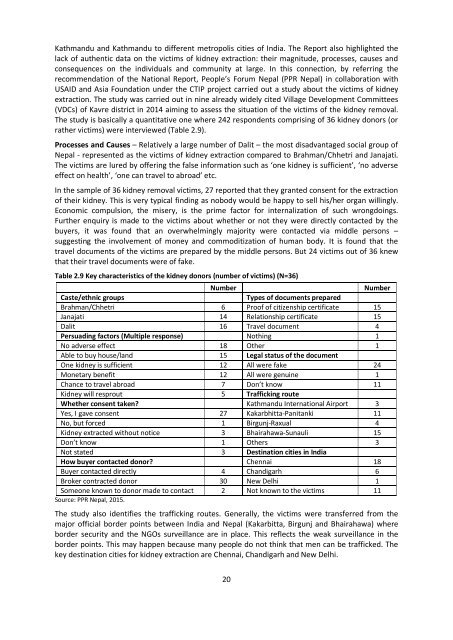TRAFFICKING IN PERSONS
1Spfyta
1Spfyta
You also want an ePaper? Increase the reach of your titles
YUMPU automatically turns print PDFs into web optimized ePapers that Google loves.
Table 2.11 Overview of child labor situation in Nepal<br />
Description<br />
Number/percent<br />
Total estimated number of children (5-17 years of age)<br />
7.77 million<br />
Estimated number of working children<br />
3.14 million<br />
Children working (% of total) 40.4<br />
Estimated number of child laborers<br />
1.6 million<br />
Child laborers (% of total) 20.6<br />
Estimated number of children at risk<br />
0.62 million<br />
Children at risk (% of the total) 8.0<br />
Source: ILO, 2012a.<br />
Estimated numbers of child laborers in five worst forms are available from Rapid Assessments of<br />
World Education and Plan Nepal conducted in 2012 (see Appendix 2.4). They include: i) Brick kilns, ii)<br />
transport sector, iii) child porters, iv) child domestic workers and v) child labor in hotel/restaurants.<br />
In case of Brick kilns, 18 percent of the total 75,169 labors in Kathmandu valley and 14 percent of the<br />
total 106,355 laborers outside of the Kathmandu valley are child laborers. Recent data is also<br />
available for child laborers in brick kilns from Nepal Good Weave Foundation interventions areas<br />
from Lalitapur, Bhaktapur, Sarlahi and Rupandehi (Appendix 2.4a).<br />
In case of transport sector, there were 2,035 child laborers in Kathmandu valley and it was 1850 in<br />
outside of the Kathmandu valley (24 districts were studied). More than one-fourth (26%) consists of<br />
children under 14 years of age. With regard to child porters, the estimated numbers of child porters<br />
were 16,000 in the 30 districts of Nepal. Of them, an overwhelmingly majority (77%) are boys and 64<br />
percent are short-distance child porters while the rest 36 percent are long-distance child porters.<br />
The estimated number of child domestic workers was 172,000 (61,000 from rural areas, 48,000 from<br />
rural but urban oriented areas and 63,000 from urban areas). Of the total child domestic workers,<br />
more than half (56%) are under 14 years of age. By sex, majority (57%) are girls against boys (43%).<br />
An estimated number of child laborers in tea shops/hotels were 77,000. Of which, majority (48,000)<br />
are in urban areas.<br />
2.6.2 Vulnerability of Trafficking: Harmful Practices<br />
The UN Committee on the Rights of the Child (sixteenth session) observes that practices such as<br />
deuki, jhumas, kamlari, badi 3 and prevalence of early and forced marriage are harmful for the<br />
children’s physical and well-being. While these practices (Deuki, Jhumas, Kamalari and Badi) have<br />
already been outlawed, it cannot be said that such practices have already abolished. These practices<br />
constitute forms of a sale of children.<br />
Although there are few studies revealing the linkage between early and child marriage and sale of<br />
children, the child/early marriage increases the vulnerability of children (Human Rights Treaty<br />
Monitoring Coordination Committee, Child Nepal, 2011). Drawing on data from the population<br />
censuses of Nepal, one can assess the prevalence of child and early marriage in Nepal (Table 2.12).<br />
Data suggest the following. First, there is no record of very early marriage (marriage before 10 years<br />
of age) after the 1981 population census. Second, the practices of child/early marriage have<br />
persisted in Nepalese society albeit the proportions of child/early marriage has consistently declined<br />
as the time elapses. Third, practices of child/early marriage is still much pronounced among female<br />
compared to males. For example, in 2011, one in 100 females aged 10-14 and 23 in 100 females<br />
aged 15-19 have already married while the comparable figures for males are less than half (0.45%)<br />
and 7 in 100 males, respectively.<br />
3 Deuki refers to offering girls to deities to fulfill religious obligations; jhumas refers to offering young girls to Buddhist<br />
monasteries for performing religious functions; kamlari refers to offering girls for domestic work to the families of<br />
landlords, and badi refers to widespread practice of prostitution among the Badi caste.<br />
22


